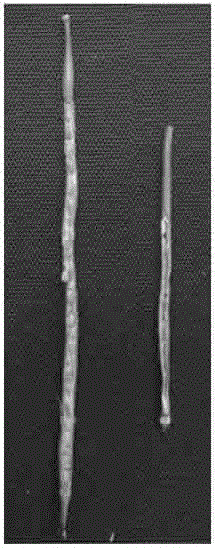Method for culturing male sterile plant through virus-induced gene silencing system
A technology for male sterility and planting, applied in botany equipment and methods, genetic engineering, plant genetic improvement, etc., can solve problems such as restrictions, hybrid sterile plants, and increased production costs, and achieve short time and low field workload Less, cost-saving effect
- Summary
- Abstract
- Description
- Claims
- Application Information
AI Technical Summary
Problems solved by technology
Method used
Image
Examples
Embodiment 1
[0039] 1. Construction of VIGS vector for silencing rapeseed COI1 gene
[0040] 1.1 Acquisition of rapeseed COI1 gene cDNA
[0041] Cultivate rapeseed seedlings, and when they grow to about 10cm, use TRIZOL method to extract the total RNA of stems and cotyledons, obtain the cDNA corresponding to the total RNA of rapeseed by reverse transcription, take a small amount of cDNA as a template, and the forward primer is: AAATCTAGAGTGTCTCCGAACCATAGGC, reverse The primer is: TTCTCTCACCTCCCAAGCTG, and a 514bp cDNA fragment of rapeseed COI1 gene (SEQ ID NO.1 (1181) to (1694)) is obtained by PCR amplification.
[0042] 1.2 Acquisition of pTRV2 vector containing rapeseed COI1 gene
[0043] Digest the cDNA fragment of the COI1 gene with XbaI, and double-digest the plasmid pTRV2 with XbaI and EcoICRI. The restriction systems are: 1.5 μL Buffer (Buffer3), 1 μL XbaI, 5 μL COII gene cDNA fragment, add water to make up to 15 μL; 1.5 μL Buffer (Buffer MultiCore), 0.5 μL Xba1, 0.5 μL EcoICRI, 0...
Embodiment 2
[0074] 1. Sowing, vernalization and seedling cultivation of experimental rapeseed seedlings
[0075] Sowing rapeseed Zhongshuang No. 11, using plastic fiber as a fixer, MS liquid medium as a nutrient, and spraying 1 / 500 dilution of chlormequat when the stem grows to about 5cm to inhibit excessive growth of rape seedlings. Vernalization begins after half a month , The vernalization conditions are 9 hours during the day, 9°C; 15 hours at night, 40°C. After 14 days of vernalization, it was revived at 12°C for 2 days, 9 hours in the daytime, and 15 hours in the night. After recovery, they were transferred to a 25°C greenhouse for cultivation.
[0076] 2. Infect rapeseed seedlings with Agrobacterium containing VIGS vector, and cultivate rapeseed lines that silence the COI1 gene
[0077] 2.1 Agrobacterium preparation for infection
[0078] GV-C, GV-1 and GV-COI1 were added to 6ml YEB medium, 6μL Rif and 6μL Kan were added, and three single bacteria were inoculated, and the bacter...
Embodiment 3
[0103] The corresponding sequence of tobacco COI1 gene ((444)..(952) of SEQ ID NO.2) was constructed into VIGS vector, and male sterile plants of tobacco were also obtained after infecting tobacco. Such as Figure 8 As shown, silencing of the COI1 gene in tobacco resulted in sterility due to abnormal development of stamens.
[0104]
[0105]
[0106]
[0107]
[0108]
[0109]
[0110]
[0111]
[0112]
PUM
 Login to View More
Login to View More Abstract
Description
Claims
Application Information
 Login to View More
Login to View More - Generate Ideas
- Intellectual Property
- Life Sciences
- Materials
- Tech Scout
- Unparalleled Data Quality
- Higher Quality Content
- 60% Fewer Hallucinations
Browse by: Latest US Patents, China's latest patents, Technical Efficacy Thesaurus, Application Domain, Technology Topic, Popular Technical Reports.
© 2025 PatSnap. All rights reserved.Legal|Privacy policy|Modern Slavery Act Transparency Statement|Sitemap|About US| Contact US: help@patsnap.com



